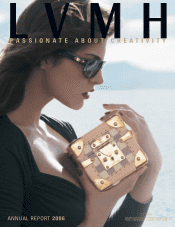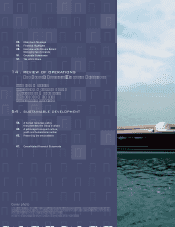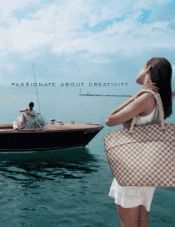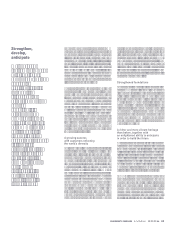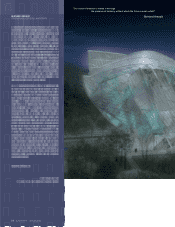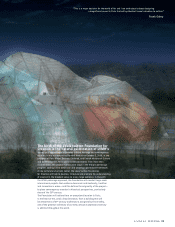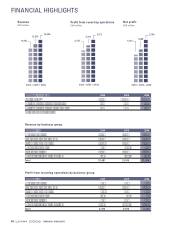Louis Vuitton 2006 Annual Report Download - page 10
Download and view the complete annual report
Please find page 10 of the 2006 Louis Vuitton annual report below. You can navigate through the pages in the report by either clicking on the pages listed below, or by using the keyword search tool below to find specific information within the annual report.
08
LVM H 2 0 0 6
MANAGING LUXURY BRANDS
lead a luxury company if you don't have a true
passion for creation. It is essential for the desi-
gner to absorb the culture of the brand so that
he or she is in harmony with its universe. At
the same time, the manager's role is not to inter-
fere in the creative process, but to support it
with strong teams and translate that process
into products and communications that can stir
emotions and excitement. Our star brands are
the perfect illustration of the power of a success-
ful symbiosis.
How would you describe the model for excel-
lence in the management of the LVMH
brands?
A.B.:The magic of our business is that there
is no single model. Each brand has its own
concept of excellence. Each brand must be
managed with respect for its uniqueness and
its own strategic vectors. However, in terms of
operational efficiency, the shared virtue of our
management teams is their openness and their
real proximity to our customers. Our brands all
have an international dimension. They are evol-
ving in a changing world; they are designed for
customers from different cultures who do not
all have the same relationship with luxury. We
have to be aware of the diversity of those expec-
tations, sense the trends, seize new opportuni-
ties for growth, and explore new markets. A
brand will not progress if we stay inside our
ivory tower; it will move forward if we visit our
stores from Paris to Shanghai, from New York to
Moscow, if we take an interest in the media,
confront points of view etc Our Group is a
professional community of exceptional size and
richness in which sharing our knowledge is
fundamental. As an example, we have recently
organized a seminar focused on China for mana-
gers from the different brands so that they can
exchange their experiences.
How can a luxury brand permanently “stick” to
trends which are, by definition, perpetually
changing, without diluting the traditional
values it has inherited?
A.B.:Louis Vuitton, Fendi, Christian Dior,
Guerlain, Dom Pérignon, Hennessy, TAG Heuer
and many other Group brands are exceptional
Creativity is at the heart of the LVMH mana-
gement philosophy. How can creative freedom
on the one hand, and market realities and the
need for rigorous management on the other
co-exist?
Antonio Belloni:This question leads to a
central component in the management of luxury
brands the manager-designer relationship. It
is true that these two roles are often seen as
conflicting. But this is clearly not our vision.
Because our businesses are artistic and commer-
cial at the same time, the success of our brands
lies in the quality of the collaboration between
managers and designers. It is inconceivable to
because they are able to place their creative
process within the flow of trends and new sensi-
tivities, without denying their founding values.
They defy time by preserving their magic, their
aspirational quality, and the loyalty connection
that binds them to their customers. These time-
less brands have an extraordinary creative heri-
tage, rich in iconic products of exceptional
longevity. And it is precisely innovation that
allows them to continue to bring this heritage
to life. Louis Vuitton's Monogram, which is
more than one hundred years old, is an inex-
haustible source of renewal and inspiration for
the contemporary designers and a continual
object of desire for customers worldwide. The
mythical Dom Pérignon, Shalimar perfume by
Guerlain, the Carrera watches from TAG Heuer,
the Liens jewelry from Chaumet and so many
of our other designs are also striking examples
of eternal youth.
Is it possible to create such icons today?
A.B.: JAdore perfume by Christian Dior is a new
icon. Launched in 1999, this fragrance is an extre-
mely elegant and modern expression of the bran-
d's traditional values. Even though there are still
millions of customers loyal to Miss Dior, which
was created in 1947, the launch of Miss Dior
Chérie in 2005 was extremely successful and
attracted a new customer segment. This is a diffe-
rent fragrance, younger and more modern, but it
carries in a modern expression all the esthetic
codes of its older sister that are the hallmarks of
a true luxury product. The bold creations of Veuve
Clicquot for the presentation of its products
strengthen its positioning as a luxury brand. The
famous Baguette bag from Fendi is only ten years
old and it is a cultural icon that is increasingly
coveted. The recently designed Spy and B Fendi
models have been highly successful and are beco-
ming new icons. They are also perfect illustra-
tions of the style and unique creativity of our
Italian brand. When quality, creativity and the
construction of a long-term image are respected,
tradition and innovation interact in a process of
positive tension. The art of managing a luxury
brand consists of defining a line, bending it as
trends evolve, but never breaking it.
MANAGING LUXURY BRANDS
Creativity and reason, tradition and innovation the secret of a successful symbiosis
Antonio
Belloni
LVMH Group
Managing Director
Interview with

